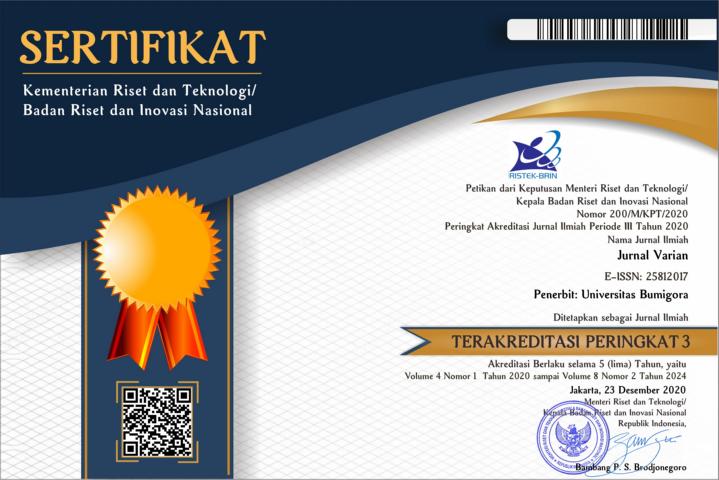Cluster Analysis of Inclusive Economic Development Using K-Means Algorithm
Abstract
This study aims to cluster 38 Districts/Cities in East Java based on the 10 forming indicators of inclusive economic development and to determine the inclusive economic growth of Districts/Cities above or below the total average. 10 indicators used in this study are GRDP per capita, GRDP by business field, Labor force participation rate, Unemployment rate, Gini ratio, Expenditure per capita, the number of poverty, Life expectancy, expectation years of schooling, and mean years of schooling. There are 3 scenarios in this study, namely 2 clusters, 3 clusters, and 4 clusters. The method of clustering in this study is using the K-means algorithm. This study uses the silhouette coefficient to evaluate the best cluster of 3 scenarios. The best k-means algorithm in this study is using 2 clusters with a silhouette coefficient of 0.87. There are 29 Districts/Cities included in cluster 1 with inclusive economic development below the total average and 9 Districts/Cities included in cluster 2 with inclusive economic development above the total average. The members of cluster 1 are mostly district areas and located in coastal or border areas and the members of cluster 2 are mostly urban or industrial areas.
References
Akramunnisa, A. and Fajriani, F. (2020). K-Means Clustering Analysis pada Persebaran Tingkat Pengangguran Kabupaten/Kota di
Sulawesi Selatan. Jurnal Varian, 3(2):103–112.
Clayman, C. L., Srinivasan, S. M., and Sangwan, R. S. (2020). K-means Clustering and Principal Components Analysis of Microarray
Data of L1000 Landmark Genes. Procedia Computer Science, 168:97–104.
Corporal-Lodangco, I. L., Richman, M. B., Leslie, L. M., and Lamb, P. J. (2014). Cluster analysis of north atlantic tropical cyclones.
Procedia Computer Science, 36:293–300.
Gbadoubissa, J. E. Z., Ari, A. A. A., and Gueroui, A. M. (2020). Efficient K-Means Based Clustering Scheme for Mobile Networks
Cell Sites Management. Journal of King Saud University-Computer and Information Sciences, 32(9):1063–1070.
Hapsari, W. R. (2019). Analisis Pertumbuhan Ekonomi Inklusif Kabupaten/Kota di Provinsi Jawa Tengah. Jurnal Litbang Sukowati:
Media Penelitian dan Pengembangan, 3(1):11–11.
Hozumi, Y., Wang, R., Yin, C., and Wei, G.-W. (2021). UMAP-Assisted K-Means Clustering of Large-Scale SARS-CoV-2 Mutation
Datasets. Computers in biology and medicine, 131:104264.
Jain, A. K. (2010). Data Clustering: 50 Years Beyond K-Means. Pattern recognition letters, 31(8):651–666.
Java, S.-E. (2020). Perkembangan beberapa Indikator Utama Sosial Ekonomi Provinsi Jawa Timur 2020.
Kakushadze, Z. and Yu, W. (2017). *K-Means and Cluster Models for Cancer Signatures. Biomolecular detection and quantification,
13:7–31.
Mooi, E., , and Sarstedt, M. (2011). A Concise Guide to Market Research: The Process, Data, and Methods Using IBM SPSS
Statistics (1st ed.). Springer-Verlag Berlin Heidelberg.
Naghizadeh, A. and Metaxas, D. N. (2020). Condensed Silhouette: An Optimized Filtering Process for Cluster Selection in K-Means.
Procedia Computer Science, 176:205–214.
Patel, E. and Kushwaha, D. S. (2020). Clustering Cloud Workloads: K-Means vs Gaussian Mixture Model. Procedia Computer
Science, 171:158–167.
Qureshi, M. N. and Ahamad, M. V. (2018). An Improved Method for Image Segmentation using K-Means Clustering with Neutrosophic Logic. Procedia computer science, 132:534–540.
Setianingtias, R., Baiquni, M., Kurniawan, A., et al. (2019). Pemodelan Indikator Tujuan Pembangunan Berkelanjutan di Indonesia.
Jurnal Ekonomi Dan Pembangunan, 27(2):61–74.
Sharma, V. and Bala, M. (2020). An Improved Task Allocation Strategy in Cloud using Modified K-Means Clustering Technique.
Egyptian Informatics Journal, 21(4):201–208.
Webster, M. (2021). Cluster Analysis. https://www.merriam-webster.com/dictionary/cluster analysis.
Xie, H., Zhang, L., Lim, C. P., Yu, Y., Liu, C., Liu, H., and Walters, J. (2019). Improving K-means Clustering with Enhanced Firefly
Algorithms. Applied Soft Computing, 84:105763.Xu, H., Croot, P., and Zhang, C. (2021). Discovering Hidden Spatial Patterns and Their Associations with Controlling Factors for
Potentially Toxic Elements in Topsoil using Hot Spot Analysis and K-Means Clustering Analysis. Environment International,
151:106456.

This work is licensed under a Creative Commons Attribution 4.0 International License.


















